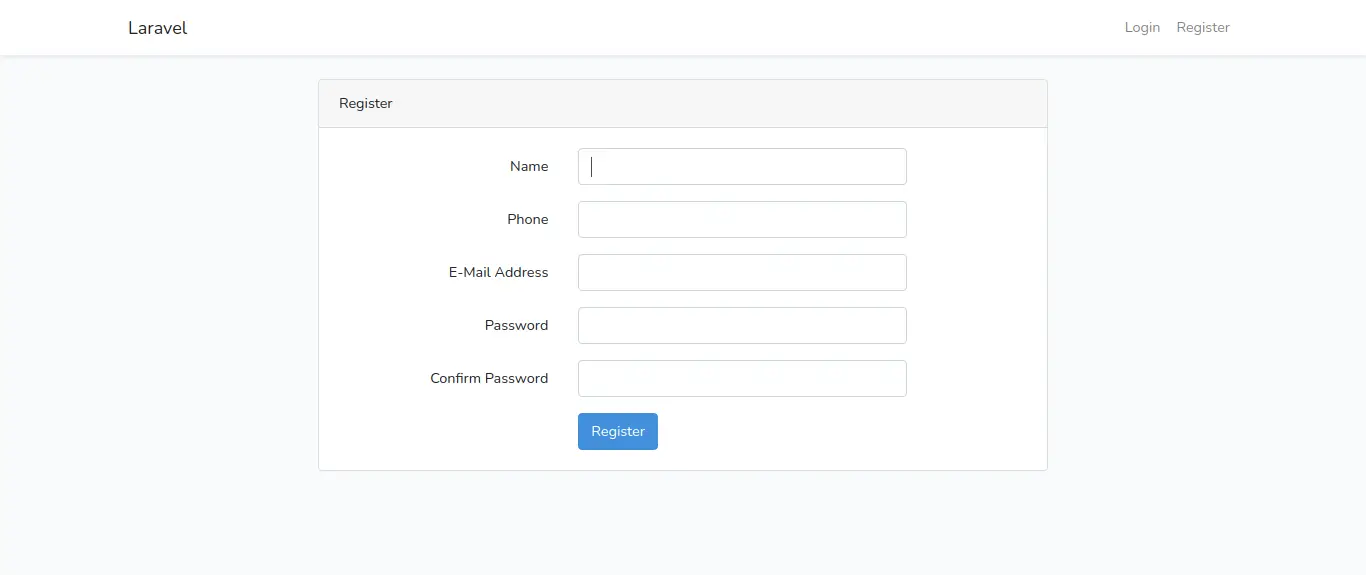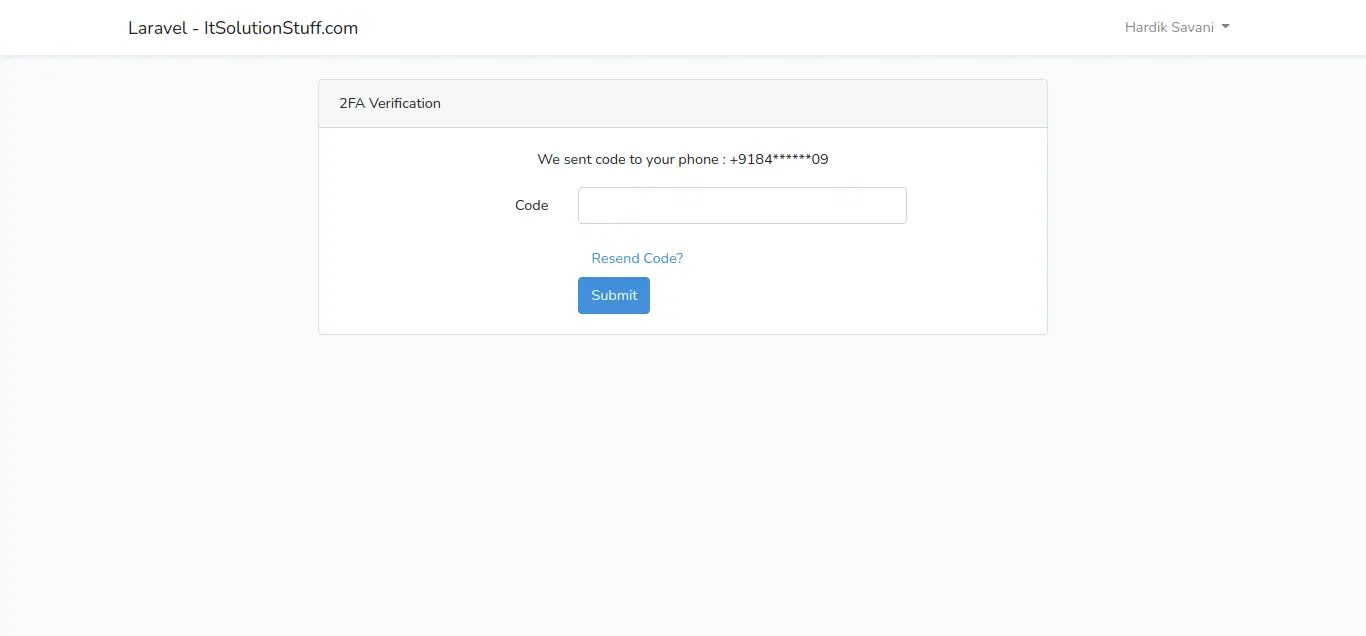How to Add Two Factor Authentication with SMS in Laravel?
Hello,
Here, i will show you how to works laravel-two-factor authentication sms. step by step explain laravel two factor authentication with sms. if you want to see example of laravel 2fa with sms authentication then you are a right place. you will learn two factor authentication twilio laravel. Let's get started with laravel two factor authentication sms.
you can use this example with laravel 6, laravel 7, laravel 8, laravel 9, laravel 10 and laravel 11 version.
In this example, i will give you step by step all info how to add two factor authentication with twilio sms in laravel 8. we will use twilio service for sending mobile text message. you can follow bellow step and make it done.
Register Page:

Verify Code Page:

Step 1 : Install Laravel
first of all we need to get fresh Laravel version application using bellow command, So open your terminal OR command prompt and run bellow command:
composer create-project laravel/laravel example-app
Step 2: Install Twilio Configuration
First you need to create and add phone number. then you can easily get account SID, Token and Number.
Create Account from here: www.twilio.com.
Next add Twilio Phone Number
Next you can get account SID, Token and Number and add on .env file as like bellow:
.env
TWILIO_SID=XXXXXXXXXXXXXXXXX
TWILIO_TOKEN=XXXXXXXXXXXXX
TWILIO_FROM=+XXXXXXXXXXX
next, we need to install twilio/sdk composer package to use twilio api. so let's run bellow command:
composer require twilio/sdk
Step 3: Create Migration for table
here, we need to create "user_codes" table and need to add phone field on users table. so let's create migration as bellow:
php artisan make:migration create_user_codes
After this command you will find one file in following path "database/migrations" and you have to put bellow code in your migration file for create user_codes table.
<?php
use Illuminate\Database\Migrations\Migration;
use Illuminate\Database\Schema\Blueprint;
use Illuminate\Support\Facades\Schema;
class CreateUserCodes extends Migration
{
/**
* Run the migrations.
*
* @return void
*/
public function up()
{
Schema::create('user_codes', function (Blueprint $table) {
$table->id();
$table->integer('user_id');
$table->string('code');
$table->timestamps();
});
Schema::table('users', function (Blueprint $table) {
$table->string('phone')->nullable();
});
}
/**
* Reverse the migrations.
*
* @return void
*/
public function down()
{
Schema::dropIfExists('user_codes');
}
}
Now you have to run this migration by following command:
php artisan migrate
Step 4: Create and Update Models
Here, we need to update user model and create new model call UserCode. so let's update code:
app/Models/User.php
<?php
namespace App\Models;
use Illuminate\Contracts\Auth\MustVerifyEmail;
use Illuminate\Database\Eloquent\Factories\HasFactory;
use Illuminate\Foundation\Auth\User as Authenticatable;
use Illuminate\Notifications\Notifiable;
use Laravel\Sanctum\HasApiTokens;
use Exception;
use Twilio\Rest\Client;
class User extends Authenticatable
{
use HasApiTokens, HasFactory, Notifiable;
/**
* The attributes that are mass assignable.
*
* @var string[]
*/
protected $fillable = [
'name',
'email',
'password',
'phone'
];
/**
* The attributes that should be hidden for serialization.
*
* @var array
*/
protected $hidden = [
'password',
'remember_token',
];
/**
* The attributes that should be cast.
*
* @var array
*/
protected $casts = [
'email_verified_at' => 'datetime',
];
/**
* Write code on Method
*
* @return response()
*/
public function generateCode()
{
$code = rand(1000, 9999);
UserCode::updateOrCreate(
[ 'user_id' => auth()->user()->id ],
[ 'code' => $code ]
);
$receiverNumber = auth()->user()->phone;
$message = "2FA login code is ". $code;
try {
$account_sid = getenv("TWILIO_SID");
$auth_token = getenv("TWILIO_TOKEN");
$twilio_number = getenv("TWILIO_FROM");
$client = new Client($account_sid, $auth_token);
$client->messages->create($receiverNumber, [
'from' => $twilio_number,
'body' => $message]);
} catch (Exception $e) {
info("Error: ". $e->getMessage());
}
}
}
app/Models/UserCode.php
<?php
namespace App\Models;
use Illuminate\Database\Eloquent\Factories\HasFactory;
use Illuminate\Database\Eloquent\Model;
class UserCode extends Model
{
use HasFactory;
public $table = "user_codes";
protected $fillable = [
'user_id',
'code',
];
}
Step 5: Create Auth Scaffold
Here, we will use laravel ui package and create auth scaffold with bootstrap framework. let's follow bellow command:
composer require laravel/ui
now let's run command for creating auth scaffold:
php artisan ui bootstrap --auth
Step 6: Create Middleware
In this step, we will create new middleware for check user has 2fa or not. so let's create new middleware with following command and code:
php artisan make:middleware Check2FA
app/Http/Middleware/Check2FA.php
<?php
namespace App\Http\Middleware;
use Closure;
use Illuminate\Http\Request;
use Session;
class Check2FA
{
/**
* Handle an incoming request.
*
* @param \Illuminate\Http\Request $request
* @param \Closure $next
* @return mixed
*/
public function handle(Request $request, Closure $next)
{
if (!Session::has('user_2fa')) {
return redirect()->route('2fa.index');
}
return $next($request);
}
}
app/Http/Kernel.php
<?php
namespace App\Http;
use Illuminate\Foundation\Http\Kernel as HttpKernel;
class Kernel extends HttpKernel
{
...
...
...
protected $routeMiddleware = [
'auth' => \App\Http\Middleware\Authenticate::class,
'auth.basic' => \Illuminate\Auth\Middleware\AuthenticateWithBasicAuth::class,
'cache.headers' => \Illuminate\Http\Middleware\SetCacheHeaders::class,
'can' => \Illuminate\Auth\Middleware\Authorize::class,
'guest' => \App\Http\Middleware\RedirectIfAuthenticated::class,
'password.confirm' => \Illuminate\Auth\Middleware\RequirePassword::class,
'signed' => \Illuminate\Routing\Middleware\ValidateSignature::class,
'throttle' => \Illuminate\Routing\Middleware\ThrottleRequests::class,
'verified' => \Illuminate\Auth\Middleware\EnsureEmailIsVerified::class,
'2fa' => \App\Http\Middleware\Check2FA::class,
];
}
Step 7: Create Route
We need to create register routes as bellow:
routes/web.php
<?php
use Illuminate\Support\Facades\Route;
/*
|--------------------------------------------------------------------------
| Web Routes
|--------------------------------------------------------------------------
|
| Here is where you can register web routes for your application. These
| routes are loaded by the RouteServiceProvider within a group which
| contains the "web" middleware group. Now create something great!
|
*/
Route::get('/', function () {
return view('welcome');
});
Auth::routes();
Route::get('/home', [App\Http\Controllers\HomeController::class, 'index'])->name('home')->middleware('2fa');
Route::get('2fa', [App\Http\Controllers\TwoFAController::class, 'index'])->name('2fa.index');
Route::post('2fa', [App\Http\Controllers\TwoFAController::class, 'store'])->name('2fa.post');
Route::get('2fa/reset', [App\Http\Controllers\TwoFAController::class, 'resend'])->name('2fa.resend');
Step 8: Create and Update Controllers
Here, we need to update RegisterController and LoginController controller file.
Also we will create TwoFAController new controller file and write code there. so let's create these files:
app/Http/Controllers/Auth/RegisterController.php
<?php
namespace App\Http\Controllers\Auth;
use App\Http\Controllers\Controller;
use App\Providers\RouteServiceProvider;
use App\Models\User;
use Illuminate\Foundation\Auth\RegistersUsers;
use Illuminate\Support\Facades\Hash;
use Illuminate\Support\Facades\Validator;
class RegisterController extends Controller
{
/*
|--------------------------------------------------------------------------
| Register Controller
|--------------------------------------------------------------------------
|
| This controller handles the registration of new users as well as their
| validation and creation. By default this controller uses a trait to
| provide this functionality without requiring any additional code.
|
*/
use RegistersUsers;
/**
* Where to redirect users after registration.
*
* @var string
*/
protected $redirectTo = RouteServiceProvider::HOME;
/**
* Create a new controller instance.
*
* @return void
*/
public function __construct()
{
$this->middleware('guest');
}
/**
* Get a validator for an incoming registration request.
*
* @param array $data
* @return \Illuminate\Contracts\Validation\Validator
*/
protected function validator(array $data)
{
return Validator::make($data, [
'name' => ['required', 'string', 'max:255'],
'phone' => ['required'],
'email' => ['required', 'string', 'email', 'max:255', 'unique:users'],
'password' => ['required', 'string', 'min:8', 'confirmed'],
]);
}
/**
* Create a new user instance after a valid registration.
*
* @param array $data
* @return \App\Models\User
*/
protected function create(array $data)
{
return User::create([
'name' => $data['name'],
'phone' => $data['phone'],
'email' => $data['email'],
'password' => Hash::make($data['password']),
]);
}
}
app/Http/Controllers/Auth/LoginController.php
<?php
namespace App\Http\Controllers\Auth;
use App\Http\Controllers\Controller;
use App\Providers\RouteServiceProvider;
use Illuminate\Foundation\Auth\AuthenticatesUsers;
use Illuminate\Http\Request;
use Auth;
use App\Models\UserCode;
class LoginController extends Controller
{
/*
|--------------------------------------------------------------------------
| Login Controller
|--------------------------------------------------------------------------
|
| This controller handles authenticating users for the application and
| redirecting them to your home screen. The controller uses a trait
| to conveniently provide its functionality to your applications.
|
*/
use AuthenticatesUsers;
/**
* Where to redirect users after login.
*
* @var string
*/
protected $redirectTo = RouteServiceProvider::HOME;
/**
* Create a new controller instance.
*
* @return void
*/
public function __construct()
{
$this->middleware('guest')->except('logout');
}
/**
* Write code on Method
*
* @return response()
*/
public function login(Request $request)
{
$request->validate([
'email' => 'required',
'password' => 'required',
]);
$credentials = $request->only('email', 'password');
if (Auth::attempt($credentials)) {
auth()->user()->generateCode();
return redirect()->route('2fa.index');
}
return redirect("login")->withSuccess('Oppes! You have entered invalid credentials');
}
}
app/Http/Controllers/TwoFAController.php
<?php
namespace App\Http\Controllers;
use Illuminate\Http\Request;
use Session;
use App\Models\UserCode;
class TwoFAController extends Controller
{
/**
* Write code on Method
*
* @return response()
*/
public function index()
{
return view('2fa');
}
/**
* Write code on Method
*
* @return response()
*/
public function store(Request $request)
{
$request->validate([
'code'=>'required',
]);
$find = UserCode::where('user_id', auth()->user()->id)
->where('code', $request->code)
->where('updated_at', '>=', now()->subMinutes(2))
->first();
if (!is_null($find)) {
Session::put('user_2fa', auth()->user()->id);
return redirect()->route('home');
}
return back()->with('error', 'You entered wrong code.');
}
/**
* Write code on Method
*
* @return response()
*/
public function resend()
{
auth()->user()->generateCode();
return back()->with('success', 'We sent you code on your mobile number.');
}
}
Step 9: Create and Update Blade File
Here, we will update register default blade file and create new 2fa blade file. so let's update following code here.
resources/views/auth/register.blade.php
@extends('layouts.app')
@section('content')
<div class="container">
<div class="row justify-content-center">
<div class="col-md-8">
<div class="card">
<div class="card-header">{{ __('Register') }}</div>
<div class="card-body">
<form method="POST" action="{{ route('register') }}">
@csrf
<div class="form-group row">
<label for="name" class="col-md-4 col-form-label text-md-right">{{ __('Name') }}</label>
<div class="col-md-6">
<input id="name" type="text" class="form-control @error('name') is-invalid @enderror" name="name" value="{{ old('name') }}" required autocomplete="name" autofocus>
@error('name')
<span class="invalid-feedback" role="alert">
<strong>{{ $message }}</strong>
</span>
@enderror
</div>
</div>
<div class="form-group row">
<label for="name" class="col-md-4 col-form-label text-md-right">Phone</label>
<div class="col-md-6">
<input id="phone" type="text" class="form-control @error('phone') is-invalid @enderror" name="phone" value="{{ old('phone') }}" required autocomplete="phone" autofocus>
@error('phone')
<span class="invalid-feedback" role="alert">
<strong>{{ $message }}</strong>
</span>
@enderror
</div>
</div>
<div class="form-group row">
<label for="email" class="col-md-4 col-form-label text-md-right">{{ __('E-Mail Address') }}</label>
<div class="col-md-6">
<input id="email" type="email" class="form-control @error('email') is-invalid @enderror" name="email" value="{{ old('email') }}" required autocomplete="email">
@error('email')
<span class="invalid-feedback" role="alert">
<strong>{{ $message }}</strong>
</span>
@enderror
</div>
</div>
<div class="form-group row">
<label for="password" class="col-md-4 col-form-label text-md-right">{{ __('Password') }}</label>
<div class="col-md-6">
<input id="password" type="password" class="form-control @error('password') is-invalid @enderror" name="password" required autocomplete="new-password">
@error('password')
<span class="invalid-feedback" role="alert">
<strong>{{ $message }}</strong>
</span>
@enderror
</div>
</div>
<div class="form-group row">
<label for="password-confirm" class="col-md-4 col-form-label text-md-right">{{ __('Confirm Password') }}</label>
<div class="col-md-6">
<input id="password-confirm" type="password" class="form-control" name="password_confirmation" required autocomplete="new-password">
</div>
</div>
<div class="form-group row mb-0">
<div class="col-md-6 offset-md-4">
<button type="submit" class="btn btn-primary">
{{ __('Register') }}
</button>
</div>
</div>
</form>
</div>
</div>
</div>
</div>
</div>
@endsection
resources/views/2fa.blade.php
@extends('layouts.app')
@section('content')
<div class="container">
<div class="row justify-content-center">
<div class="col-md-8">
<div class="card">
<div class="card-header">2FA Verification</div>
<div class="card-body">
<form method="POST" action="{{ route('2fa.post') }}">
@csrf
<p class="text-center">We sent code to your phone : {{ substr(auth()->user()->phone, 0, 5) . '******' . substr(auth()->user()->phone, -2) }}</p>
@if ($message = Session::get('success'))
<div class="row">
<div class="col-md-12">
<div class="alert alert-success alert-block">
<button type="button" class="close" data-dismiss="alert">×</button>
<strong>{{ $message }}</strong>
</div>
</div>
</div>
@endif
@if ($message = Session::get('error'))
<div class="row">
<div class="col-md-12">
<div class="alert alert-danger alert-block">
<button type="button" class="close" data-dismiss="alert">×</button>
<strong>{{ $message }}</strong>
</div>
</div>
</div>
@endif
<div class="form-group row">
<label for="code" class="col-md-4 col-form-label text-md-right">Code</label>
<div class="col-md-6">
<input id="code" type="number" class="form-control @error('code') is-invalid @enderror" name="code" value="{{ old('code') }}" required autocomplete="code" autofocus>
@error('code')
<span class="invalid-feedback" role="alert">
<strong>{{ $message }}</strong>
</span>
@enderror
</div>
</div>
<div class="form-group row mb-0">
<div class="col-md-8 offset-md-4">
<a class="btn btn-link" href="{{ route('2fa.resend') }}">Resend Code?</a>
</div>
</div>
<div class="form-group row mb-0">
<div class="col-md-8 offset-md-4">
<button type="submit" class="btn btn-primary">
Submit
</button>
</div>
</div>
</form>
</div>
</div>
</div>
</div>
</div>
@endsection
Ok, now we are ready to run.
So let's run project using this command:
php artisan serve
open bellow UR:
localhost:8000/
Now you can simply run and check...
I hope it can help you....

